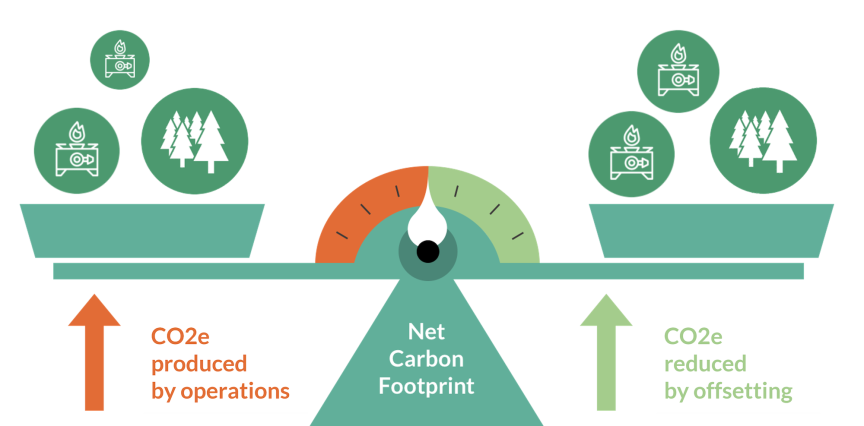Climate change has placed an urgent imperative on companies worldwide to reduce their greenhouse gas (GHG) emissions. Carbon neutrality—achieving a net balance between carbon emissions produced and removed or offset—is now a key goal for businesses striving for sustainability, regulatory compliance, and enhanced market reputation. This guide provides an in-depth look at carbon neutrality, outlining its definitions, processes, global progress, differences with related concepts (such as net-zero and climate positive), and actionable strategies—including AI-powered solutions—to help your organization lead in the low-carbon economy.
1. What Is Carbon Neutrality?
Carbon neutrality (also called “carbon-neutrality”) means that any CO₂ emitted by a business (directly or indirectly) is balanced by an equivalent amount removed or offset elsewhere.
In practical terms, a business is carbon neutral when its net carbon emissions are zero.

Key Elements
-
Emission Reduction:
Achieved through energy efficiency, switching to renewable energy, and process optimization. -
Carbon Removal:
Employing natural sinks like reforestation or technological solutions such as carbon capture and storage (CCS). -
Carbon Offsetting:
Purchasing carbon credits or investing in offset projects (e.g., renewable energy certificates, forest conservation) to compensate for remaining emissions.
For a concise explanation, refer to the United Nations Environment Programme resources on carbon neutrality.
2. Why Is Carbon Neutrality Important for Businesses?
Achieving carbon neutrality is not just about environmental responsibility—it also yields significant business benefits.
Environmental & Social Benefits
-
Mitigating Climate Change:
Aligning with global climate targets like those set by the Intergovernmental Panel on Climate Change (IPCC) helps limit global warming. -
Enhancing Reputation:
Transparent sustainability practices build trust among consumers, employees, and communities. -
Social Responsibility:
Demonstrating leadership in sustainability can attract talent and foster positive corporate culture.
Economic & Regulatory Benefits
-
Cost Reduction & Efficiency:
Energy-saving measures and process improvements often lead to lower operational costs. -
Investor Confidence:
Robust GHG reporting and commitment to net-zero strategies lower climate risk perceptions. Frameworks such as the Task Force on Climate-related Financial Disclosures (TCFD) provide investors with critical insights. -
Regulatory Compliance:
Many jurisdictions now require GHG reporting. For example, the U.S. EPA’s Greenhouse Gas Reporting Program (GHGRP) mandates detailed emissions disclosures.
3. Global Carbon Neutrality Progress and Policy Milestones
Countries and regions worldwide have set ambitious targets and enacted policies to move toward carbon neutrality.
Timeline of Global Progress
| Country/Region | Target Year | Status | Source |
|---|---|---|---|
| European Union | 2050 | Political agreement; CSRD in progress | European Commission |
| United States | Varies (2050 net-zero proposals) | EPA GHGRP and SEC proposals in development | US EPA |
| China | 2060 | Policy targets; included in the 14th Five-Year Plan | UNFCCC, 2020 |
| Japan | 2050 | Announced policy targets; roadmap under development | Japan FSA |
| United Kingdom | 2050 | Legislation in place; climate change act | UK Government |
Global Context
Since the adoption of the Kyoto Protocol (1997) and the Paris Agreement (2015), the international community has recognized that limiting global warming requires significant reductions in GHG emissions. In 2015, world leaders pledged to limit temperature rise to well below 2°C and pursue efforts to cap it at 1.5°C. Achieving carbon neutrality is critical to meeting these targets.
4. Comparing Carbon Neutrality, Net-Zero, and Climate Positive
Understanding the terminology is key to evaluating sustainability claims:
Definitions
-
Carbon Neutrality:
Balancing CO₂ emissions with equivalent removals or offsets so that net emissions equal zero. -
Net Zero Emissions:
Achieving a balance between all emitted greenhouse gases (GHG) and those removed from the atmosphere. This term is often used interchangeably with carbon neutrality but may include gases beyond CO₂. -
Climate Positive (or Carbon Negative):
Going beyond neutralization by removing more CO₂ from the atmosphere than is emitted. This represents an active, beneficial environmental impact.
Key Differences
| Term | Definition | Key Focus | Example |
|---|---|---|---|
| Carbon Neutrality | Achieving net zero CO₂ emissions through reduction and offsetting | Balance of CO₂ emissions | A company that offsets residual emissions by investing in reforestation projects. |
| Net Zero Emissions | Balancing all GHG emissions (including CH₄, N₂O) with removals | Comprehensive GHG balance | An organization that reduces emissions from operations and offsets any remaining GHGs through technology like CCS. |
| Climate Positive | Removing more GHGs than are emitted, yielding a net environmental benefit | Active carbon removal | A firm that not only offsets its emissions but also invests in large-scale carbon removal projects such as direct air capture. |
5. Achieving Carbon Neutrality: The Process
Achieving carbon neutrality typically involves a multi-step process:
-
Commitment:
Announce a clear target to achieve carbon neutrality. This commitment can be made at the corporate, regional, or product level. -
Calculation and Analysis:
Assess your total carbon footprint by measuring direct (Scope 1) and indirect (Scope 2 and Scope 3) emissions. Use standardized methodologies (e.g., GHG Protocol) for consistency. -
Implementation:
Introduce energy and environmental management systems to monitor and control emissions. This includes adopting renewable energy and increasing operational efficiency. -
Reduction:
Implement strategies to reduce emissions:-
Upgrade infrastructure for energy efficiency.
-
Transition to renewable energy sources (e.g., solar, wind).
-
Optimize supply chain operations.
-
-
Offsetting:
Compensate for any residual emissions through carbon offsets. This might involve investing in reforestation projects, renewable energy certificates, or technological carbon removal. -
Monitoring and Evaluation:
Regularly assess performance against targets, adjust strategies, and report progress transparently.
For practical tools to calculate your carbon footprint, check out software solutions provided by Plan A Sustainability Platform (insert actual link) and Carbon Footprint Calculator.
6. Actionable Strategies for Enhanced Compliance and Performance
Achieving carbon neutrality requires a blend of proven practices and innovative technologies. Advanced AI solutions are increasingly critical to this process.
6.1 Emission Reduction Strategies
-
Energy Efficiency Upgrades:
Retrofit buildings with LED lighting, efficient HVAC systems, and energy management controls. -
Renewable Energy Transition:
Invest in on-site renewable installations or purchase renewable energy certificates (RECs) to lower Scope 2 emissions. -
Process Optimization:
Implement lean manufacturing practices to reduce waste and improve efficiency.
6.2 Leveraging AI for Enhanced Performance
-
Real-Time Monitoring and IoT Integration:
Use AI-driven sensors to collect real-time emissions data across facilities. Platforms like Climate Trace provide independent verification using satellite imagery and AI analytics. -
Predictive Analytics:
Employ AI to forecast equipment failures and operational inefficiencies, allowing proactive maintenance and emission reductions. -
Automated Reporting and Compliance:
Integrate AI-powered tools to aggregate and analyze data, ensuring that reports meet regulatory requirements such as those mandated by the US EPA GHGRP and the EU’s CSRD. -
Supply Chain Data Integration:
Implement digital platforms that standardize emissions reporting across your value chain. AI can help analyze supplier data to improve the accuracy of Scope 3 emissions.
6.3 Collaborative and Market-Based Approaches
-
Carbon Offsetting:
Invest in verified offset projects that meet standards like Gold Standard and Verified Carbon Standard (VERRA). Ensure offsets represent additional and permanent reductions. -
Carbon Trading:
Explore participation in carbon trading schemes to leverage market mechanisms for cost-effective emission reductions. Note, however, that this approach is often critiqued for not reducing overall emissions directly. -
Stakeholder Engagement:
Foster transparency and collaboration with investors, customers, and suppliers. Regular reporting and open dialogue can build trust and drive collective action.
7. The Role of SBTi in Achieving Carbon Neutrality
The Science Based Targets initiative (SBTi) is a crucial framework that helps businesses align their emissions reduction targets with climate science. SBTi sets rigorous, science-based targets that ensure companies contribute to the global effort to limit temperature rise to 1.5°C or 2°C.
Why SBTi Matters
-
Science-Based Goals:
SBTi targets are derived from climate science, ensuring that corporate actions are in line with global climate objectives. -
Credibility and Transparency:
Adopting SBTi standards enhances corporate credibility and provides a clear roadmap for emissions reductions. -
Investor Confidence:
Investors favor companies with measurable, science-based targets as they reflect a proactive approach to mitigating climate risks.
For an in-depth look at why SBTi is critical for corporate emissions management, please refer to our detailed article: 7 Key Reasons Why SBTi Is Critical for Corporate Emissions Management.
8. Global Carbon Neutrality Trends and Policy Milestones
The journey to carbon neutrality is influenced by a rapidly evolving policy landscape. Governments worldwide have set ambitious targets to achieve net zero emissions, which in turn drive corporate actions.
Key Policy Milestones
-
Kyoto Protocol (1997):
Set the stage for international emissions reductions. -
Paris Agreement (2015):
Committed signatories to limit global warming to 1.5°C–2°C, with many nations pledging carbon neutrality by mid-century. -
EU Climate Law (2020):
Mandates that the European Union reach net zero emissions by 2050 (European Commission). -
National Commitments:
-
China: Aims for carbon neutrality by 2060 (UNFCCC, 2020).
-
Japan: Targets net zero emissions by 2050 (Japan’s FSA).
-
United Kingdom: Legislation requires net zero by 2050 (UK Government).
-
Global Overview Table
| Country/Region | Target Year | Status/Legislation | Source |
|---|---|---|---|
| European Union | 2050 | Legislation in place; CSRD under implementation | European Commission |
| United States | 2050 (proposed) | SEC proposals; EPA GHGRP mandates | US EPA |
| China | 2060 | National policy included in the 14th Five-Year Plan | UNFCCC |
| Japan | 2050 | Government targets announced | Japan FSA |
| United Kingdom | 2050 | Legislation in place | UK Government |
9. Understanding the Difference: Carbon Neutral vs. Net Zero vs. Climate Positive
These terms are often used interchangeably, but they have distinct meanings:
Carbon Neutrality
-
Definition: Balancing emitted CO₂ with equivalent removals or offsets.
-
Focus: Eliminating net carbon emissions.
-
Example: A company offsets its emissions through reforestation projects.
Net Zero Emissions
-
Definition: Achieving a balance between all GHG emissions (including CH₄, N₂O) and those removed.
-
Focus: Comprehensive GHG balance across all gases.
-
Example: An organization uses renewable energy and CCS to neutralize all its emissions.
Climate Positive (Carbon Negative)
-
Definition: Removing more CO₂ from the atmosphere than is emitted.
-
Focus: Creating a net environmental benefit.
-
Example: A firm not only offsets its emissions but also invests in direct air capture projects to reduce atmospheric CO₂.
For a non-misleading guide on these terms, see Tara Bernoville’s analysis (replace with an actual URL when available).
10. Future Outlook and Strategic Shifts
As the global community works toward a sustainable future, several trends are shaping the journey to carbon neutrality:
-
Technological Integration:
Wider adoption of AI, IoT, and blockchain for enhanced real-time data collection and verification. -
Global Standardization:
Efforts by bodies such as the International Sustainability Standards Board (ISSB) are driving harmonization across reporting standards. -
Enhanced Financial Integration:
Sustainability metrics are increasingly embedded into financial decision-making processes, influencing green investment trends. -
Supply Chain Collaboration:
Strengthening partnerships across the value chain is essential for accurately managing Scope 3 emissions and achieving collective emission reductions.
For more detailed forecasts, see the latest sustainability reports from Bloomberg and McKinsey.
11. Call-to-Action: Transform Your Carbon Neutrality Strategy with Cedars Digital
Achieving carbon neutrality is both a strategic necessity and a competitive advantage in today’s low-carbon economy. At Cedars Digital, we leverage cutting-edge AI and digital solutions to streamline carbon accounting, enhance data accuracy, and ensure robust regulatory compliance. Our innovative platforms empower businesses to reduce emissions, optimize operations, and build a sustainable future.
Ready to transform your sustainability strategy?
Contact Cedars Digital today and let us help you achieve superior performance on your path to carbon neutrality.
12. Conclusion
Carbon neutrality represents a critical milestone for businesses committed to mitigating climate change, reducing operational risks, and meeting regulatory requirements. By understanding and implementing robust carbon accounting frameworks—such as the GHG Protocol, ISO 14064, and PAS 2060—and by embracing innovative strategies like AI-driven monitoring and predictive analytics, organizations can effectively reduce their carbon footprint and achieve net zero or even climate positive outcomes.
This comprehensive guide has explored the definition, importance, global progress, and practical strategies for achieving carbon neutrality. As technology and regulations evolve, a proactive and transparent approach to GHG management will continue to unlock competitive and environmental advantages.
13. References
-
Corporate Finance Institute. (2023). Carbon Accounting. Retrieved from https://corporatefinanceinstitute.com/resources/esg/carbon-accounting/
-
European Commission. (n.d.). Corporate Sustainability Reporting Directive (CSRD). Retrieved from https://ec.europa.eu/info/business-economy-euro/company-reporting-and-auditing/company-reporting/corporate-sustainability-reporting_en
-
GHG Protocol. (2023). Greenhouse Gas Protocol. World Resources Institute. Retrieved from https://ghgprotocol.org
-
ISO. (n.d.). ISO 14064: Greenhouse Gas Accounting and Verification. Retrieved from https://www.iso.org/iso-14064-environmental-management.html
-
International Energy Agency. (2021). Carbon Capture, Utilisation and Storage: The role of CCS in achieving net zero. Retrieved from https://www.iea.org/reports/carbon-capture-utilisation-and-storage
-
McKinsey & Company. (2020). Sustainability Insights. Retrieved from https://www.mckinsey.com/industries/sustainability/our-insights
-
Science Based Targets initiative. (2021). Net Zero Corporate Standard. Retrieved from https://www.sbtibc.org
-
TCFD. (2017). Recommendations of the Task Force on Climate-related Financial Disclosures. Retrieved from https://www.fsb-tcfd.org
-
U.S. EPA, OAR. (2022). Greenhouse Gas Reporting Program. Retrieved from https://www.epa.gov/climateleadership/scopes-1-2-and-3-emissions-inventorying-and-guidance
-
United Nations Framework Convention on Climate Change (UNFCCC). (n.d.). Kyoto Protocol. Retrieved from https://unfccc.int/kyoto_protocol
-
Climate Trace. (n.d.). Climate Trace. Retrieved from https://www.climatetrace.org
-
CDP. (2019). Briefing: What are Scope 3 Emissions? Retrieved from https://www.cdp.net/en/articles/media/briefing-what-are-scope-3-emissions




